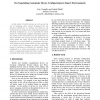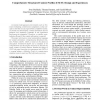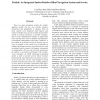PERCOM
2004
ACM
15 years 1 days ago
2004
ACM
In mobile ad hoc networks, nodes interact peer-to-peer. They self-organize, share workloads and provide services that they also use. There are middleware platforms, designed for t...
PERCOM
2004
ACM
15 years 1 days ago
2004
ACM
As the number of mobile devices we carry grows, the job of managing those devices throughout the day becomes cumbersome. In addition, the ability to use mobile devices in unethica...
PERCOM
2004
ACM
15 years 1 days ago
2004
ACM
In dynamic heterogeneous environments, such as Pervasive Computing, context-aware adaptation is a key concept to meet the varying requirements of different clients. To enable such...
PERCOM
2004
ACM
15 years 1 days ago
2004
ACM
In this paper, we introduce the Virtual Paths Routing (VPR) Protocol for ad hoc wireless networks. VPR provides highly dynamic, correct, and efficient paths creation and maintenan...
PERCOM
2004
ACM
15 years 1 days ago
2004
ACM
In previous work [1], we introduced a distributed middleware infrastructure for managing physicallybounded, standalone pervasive computing environments, which we refer to as Activ...
PERCOM
2004
ACM
15 years 1 days ago
2004
ACM
: Service Discovery as an essential element in pervasive computing environments is widely accepted. Much active research on service discovery has been conducted, but privacy has be...
PERCOM
2004
ACM
15 years 1 days ago
2004
ACM
In this paper, we analyze the role of the social group in a Ubiquitous Computing (Ubicomp) environment as a source of contextual information. A model is presented to address the s...
PERCOM
2004
ACM
15 years 1 days ago
2004
ACM
With the advent of tiny networked devices, Mark Weiser's vision of a world embedded with invisible computers is coming to age. Due to their small size and relative ease of dep...
PERCOM
2004
ACM
15 years 1 days ago
2004
ACM
A framework for the dynamic aggregation of ubiquitous computers is presented. The framework aggregates applications from more than one mobile component that can migrate from compu...
PERCOM
2004
ACM
15 years 1 days ago
2004
ACM
There are many navigation systems for visually impaired people but few can provide dynamic interactions and adaptability to changes. None of these systems work seamlessly both ind...







